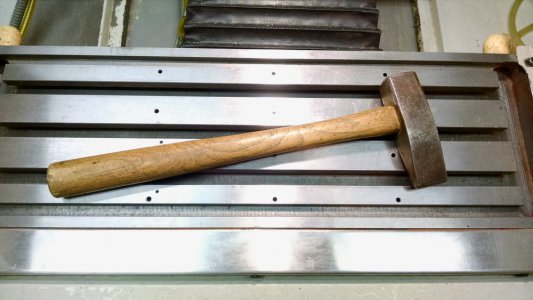-
Welcome back Guest! Did you know you can mentor other members here at H-M? If not, please check out our Relaunch of Hobby Machinist Mentoring Program!
You are using an out of date browser. It may not display this or other websites correctly.
You should upgrade or use an alternative browser.
You should upgrade or use an alternative browser.
Very cool video. Japanese Hammer making.
- Thread starter woodchucker
- Start date
- Joined
- Mar 26, 2018
- Messages
- 8,411
Hammers come with a warning to wear safety glasses.I expect that it worked because hammer faces are generally not that hard
As you say the faces couldn't be too hard or cracking or broken flying bits may occur.
The blacksmith is a true artist in my unqualified opinion.
His heat treating process is probably something he has practiced for decades.
- Joined
- Mar 26, 2018
- Messages
- 8,411
Have you ever seen Tom Lipton's hammer inventory? Very extensive.Makes me want to buy a hammer! Anybody got a recommendation?
Lots of hammers man, what you gonna do with it?
Build a house, frame a house, finish a house, peen copper, drive a pin, drive tacks, soft blow, etc.. how much should it weigh?
I just counted mine. I only have 16 hammers.
- Joined
- Feb 1, 2015
- Messages
- 9,640
His skill is unquestionable. Blacksmiths making something like a chisel, hammer, or axe would typically heat the entire piece to a hardening temperature and the quench just the working end. They would then quickly polish the working end and allow the residual heat to travel back to the working end. when the color was right, they would quench the tool again, preserving the characteristics in the tool. He is doing this without the benefit of any indicator other than elapsed time. He probably has some mantra that he recites under his breath to time the process.. Something like," one thousand one, one thousand two, etc.". Add to that, the hardening temperature has to be correct as well so he has to be able to differentiate between the various shades of orange t control the process.Hammers come with a warning to wear safety glasses.
As you say the faces couldn't be too hard or cracking or broken flying bits may occur.
The blacksmith is a true artist in my unqualified opinion.
His heat treating process is probably something he has practiced for decades.
I have not seen forge welding a steel face to a hammer body before. It was a practice for making an axe or hatchet where a diamond shaped piece of high carbon steel was forge welded into a slot in the wrought iron body to make the cutting edge. Onr has to realize rgat steel was extremely precious in times gone by. Steel was commonly made by the blacksmith himself and was a closely guarded secret. Making a hammer entirely out of steel would have been an unnecessary waste of material.
I found the style of eye use interesting. We use an oval eye for hammers. I expect that creating stress risers in the steel isn't really a problem since the wooden handle is the part the would yield under stress. I made a punch for punching hammer eyes. from a piece of 1" square rebar. For a handle, I used a length of 3/4" pipe welded on. The punch is a struck rather than striking tool so this type of handle works.
I have made a few hammers myself. One I made 45 years ago is still one of my favorites. I don't recall the source of the steel used but to complete the hammer, I don't recall the source of the steel used but to complete the hammer, went out and cut a branch drom a hickory tree and shaped the handle. The handle in the photo below is the original. The hammer has had use far exceeding that would be expected of it and still looks great.
I made another hammer from the shaft connecting a 4WD transmission and the transfer case. I made it with one flat face and one slightly domed face. This style is called a rounding hammer and used by farriers to make horse shoes. It was a neat hammer because I retained the origin spline around the center of the hammer. Unfortunately it went with my ex wife when she left and I don't have a picture of it. More recently, I made a toffee hammer for my wife. That story is posted in another thread.

- Joined
- Sep 10, 2013
- Messages
- 562
I think the Flux is borax with iron filings mixed in. The iron gives a little stckyness to hold the face semi inplace before the weld. He placed some more Flux on out side of the face joint then finished the weld. Tool steel was very expensive after WWII so that is why just the face gets the tool steel. Japanese smith's are very much artisans.
CH
CH
- Joined
- Jun 7, 2013
- Messages
- 10,111
I have a box of Anti Borax flux that obvious has tiny steel chips in it, have not tried it out yet.
- Joined
- Jun 7, 2013
- Messages
- 10,111
Sometimes rough treatment of a grinding wheel can help breakdown the abrasive grain bond and make the wheel grind more freely and cooler, but better to choose a wheel with a softer bond.Cool video and he's skilled for sure but, his grinding technique would drive me bonkers. Reminds me of my father in law, every move he makes has some amount of anger or excessive force!

